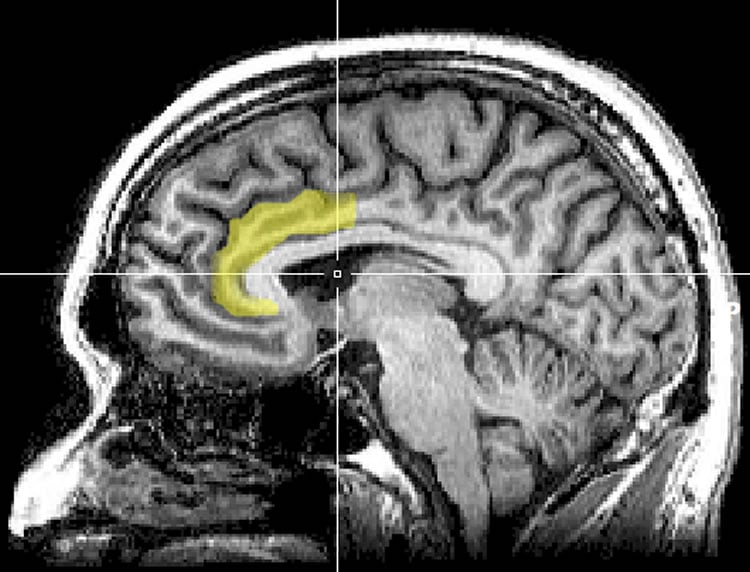Summary: A new study reveals a brain area that lights up when we do good for others is more active in empathetic people.
Source: University of Oxford.
Brain area that lights up when we do good for others is more active in more empathetic people.
Scientists from Oxford University and UCL have identified part of our brain that helps us learn to be good to other people. The discovery could help understanding of conditions like psychopathy where people’s behaviour is extremely antisocial.
The researchers were led by Dr Patricia Lockwood, who explained: ‘Prosocial behaviours are social behaviours that benefit other people. They are a fundamental aspect of human interactions, essential for social bonding and cohesion, but very little is currently known about how and why people do things to help others.
‘Although people have a remarkable inclination to engage in prosocial behaviours there are substantial differences between individuals. Empathy, the capacity to vicariously experience and understand another person’s feelings has been put forward as a critical motivator of prosocial behaviours, but we wanted to test why and how they might be linked.’
The scientists used a well-understood model of how people learn to maximise good outcomes for themselves and applied this model to understand how people learn to help others. While being scanned in a MRI machine, volunteers had to work out which symbols were more likely to give them, or someone else, a reward.
They found that while people readily learn to make choices that benefit other people, they do not learn it quite as fast as they learn to benefit themselves. However, they also identified a particular brain area involved in learning to get the best result for other people.
Dr Lockwood said: ‘A specific part of the brain called the subgenual anterior cingulate cortex was the only part of the brain that was activated when learning to help other people. Put another way, the subgenual anterior cingulate seems to be especially tuned to benefiting other people.

‘However, this region of the brain was not equally active in every person. People who rated themselves as having higher levels of empathy learnt to benefit others faster than those who reported having lower levels of empathy. They also showed increased signalling in their subgenual anterior cingulate cortex when benefitting others.’
‘This the first time anyone has shown a particular brain process for learning prosocial behaviours – and a possible link from empathy to learning to help others. By understanding what the brain does when we do things for other people, and individual differences in this ability, we are better placed to understand what is going wrong in those whose psychological conditions are characterised by antisocial disregard for others.’
Funding: This work was supported by the Medical Research Council, Birkbeck — University College London Centre for Neuroimaging.
Source: Tom Calver – University of Oxford
Image Source: This NeuroscienceNews.com image is in the public domain.
Original Research: Abstract for “Neurocomputational mechanisms of prosocial learning and links to empathy” by Patricia L. Lockwood, Matthew A. J. Apps, Vincent Valton, Essi Viding, and Jonathan P. Roiser in PNAS. Published online August 15 2016 doi:10.1073/pnas.1603198113
[cbtabs][cbtab title=”MLA”]University of Oxford. “Finding the Brain’s Generosity Center.” NeuroscienceNews. NeuroscienceNews, 15 August 2016.
<https://neurosciencenews.com/generosity-empathy-neuroscience-4850/>.[/cbtab][cbtab title=”APA”]University of Oxford. (2016, August 15). Finding the Brain’s Generosity Center. NeuroscienceNews. Retrieved August 15, 2016 from https://neurosciencenews.com/generosity-empathy-neuroscience-4850/[/cbtab][cbtab title=”Chicago”]University of Oxford. “Finding the Brain’s Generosity Center.” https://neurosciencenews.com/generosity-empathy-neuroscience-4850/ (accessed August 15, 2016).[/cbtab][/cbtabs]
Abstract
Neurocomputational mechanisms of prosocial learning and links to empathy
Reinforcement learning theory powerfully characterizes how we learn to benefit ourselves. In this theory, prediction errors—the difference between a predicted and actual outcome of a choice—drive learning. However, we do not operate in a social vacuum. To behave prosocially we must learn the consequences of our actions for other people. Empathy, the ability to vicariously experience and understand the affect of others, is hypothesized to be a critical facilitator of prosocial behaviors, but the link between empathy and prosocial behavior is still unclear. During functional magnetic resonance imaging (fMRI) participants chose between different stimuli that were probabilistically associated with rewards for themselves (self), another person (prosocial), or no one (control). Using computational modeling, we show that people can learn to obtain rewards for others but do so more slowly than when learning to obtain rewards for themselves. fMRI revealed that activity in a posterior portion of the subgenual anterior cingulate cortex/basal forebrain (sgACC) drives learning only when we are acting in a prosocial context and signals a prosocial prediction error conforming to classical principles of reinforcement learning theory. However, there is also substantial variability in the neural and behavioral efficiency of prosocial learning, which is predicted by trait empathy. More empathic people learn more quickly when benefitting others, and their sgACC response is the most selective for prosocial learning. We thus reveal a computational mechanism driving prosocial learning in humans. This framework could provide insights into atypical prosocial behavior in those with disorders of social cognition.
“Neurocomputational mechanisms of prosocial learning and links to empathy” by Patricia L. Lockwood, Matthew A. J. Apps, Vincent Valton, Essi Viding, and Jonathan P. Roiser in PNAS. Published online August 15 2016 doi:10.1073/pnas.1603198113






